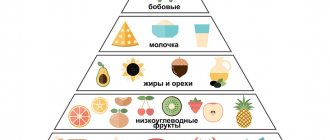Knowing the daily calorie intake, as well as the required amount of proteins, fats and carbohydrates, a person can easily monitor nutrition and control eating behavior. It is quite difficult to independently calculate the norm of KBZHU; your numerous requests under this article are confirmation of this. Therefore, now the site has the simplest calculation of KBZHU - an online calculator for counting calories for losing weight, gaining weight or keeping in shape.
Squirrels
1 gram of protein contains 4 kcal.
Proteins are the building blocks of the body; proteins are used to maintain muscles, for strong immunity, and to transmit signals between cells.
On average, it is recommended to consume proteins in the amount of 10-35% of daily calories. Big difference, isn't it? How much protein to consume depends on the nutritional goals a person wants to achieve, as well as age, health, body composition, and much more.
There is a lot of protein, for example, in poultry, meat, eggs, fish, tofu and lentils.
Expert opinion
The main and determining factor for losing weight is the psychology of eating behavior. A competent specialist supervises the patient throughout the entire weight loss process and helps him solve the following issues:
- goal setting, search for motivation tools;
- analysis of existing psychological problems: often people eat stress, eat for company or out of boredom - all this is wrong, each of these situations requires searching for a different “solution”;
- establishing relationships with loved ones, friends, colleagues: moral support is extremely important for losing weight;
- tasty food can be a kind of “reward” - for hard work, for a task successfully completed: food should be a way to satisfy the needs of the body, you should not make a cult out of it.
In fact, weight loss is a long process that has a large number of pitfalls and hidden difficulties. Only 5% of people are able to lose weight on their own, without any help. For everyone else, it’s better to immediately seek help from weight loss specialists, rather than test your body’s strength.
Fats
Among proteins, fats and carbohydrates, fats are the highest in calories: 1 gram of fat contains 9 kcal. However, the body needs fats for energy and important functions, such as producing hormones, absorbing nutrients, and maintaining body temperature.
On average, it is recommended to consume fats in the amount of 20-30% of daily calories. However, many people have success with high-fat diets (such as the keto diet).
There is a lot of fat in vegetable and butter, avocados, nuts, some types of meat and fatty fish.
The role of basic activity in losing weight
Recent research by scientists shows that basic activity in losing weight can have a greater effect than efforts in the gym. But controlling it is not an easy task, because our body resists excess energy expenditure. Normally, you need to spend 135 minutes to more than two hours moving every day. This includes walking, household chores, breaks for active rest during sedentary work. It would seem like a small thing: 10 minutes of warm-up after every hour of sitting at work - but a week adds up to 660 calories burned. To lose weight, you need to burn 500 calories daily, and 3500 per week. Let us leave 300 calories per day for training. But if we neglect movement the rest of the time, there will be no miracle: “unburned calories” will remain in us as extra pounds. Basic activity is the reserve that everyone who is faced with the plateau effect should pay attention to.
Carbohydrates
Carbohydrates usually refer to sugar, starch and fiber.
Most types of carbohydrates are broken down into glucose or sugar, which the body can either use for energy here and now or store for future use as glycogen (the body's storage form of glucose) in the liver and muscles.
There are 4 kcal in 1 gram of carbohydrates (as in 1 gram of protein).
Calories (cal) and kilocalories (kcal) are often confused. When talking about nutrition, kilocalories (kcal) are always used. There are 1,000 calories in one kilocalorie. For example, we say that a bun has 300 kcal or 300,000 calories.
Typically, carbohydrates take up the lion's share of the calories a person consumes daily.
How many carbohydrates to eat is one of the most discussed topics in nutrition. On average, it is recommended to consume carbohydrates in the amount of 45-65% of daily calories.
Grains, starchy vegetables (such as potatoes), legumes, dairy products, fruits and vegetables are high in carbohydrates.
In short: the food we eat has calories and consists of proteins, fats and carbohydrates (KBJU).
1 gram of protein and 1 gram of carbohydrates contain 4 kcal, fats are an exception to the rule - 1 gram of fat contains 9 kcal. The norm of KBJU is individual and depends on many parameters.
Table of BZHU products
One of the most important tasks is to select food that matches the data obtained. It is necessary to take into account the presence of mineral and vitamin compounds in it. In any case, the diet should be varied. It is best to choose the following products:
| Product | Proteins in g | Fats in g | Carbohydrates in g | Calorie content per 100 g |
| Egg | 12,7 | 10,7 | 0,8 | 144 |
| Buckwheat | 12,6 | 3,3 | 68 | 335 |
| Brown rice | 2,7 | 0,8 | 24,7 | 116 |
| Oatmeal | 11,0 | 6,1 | 65,4 | 303 |
| Pearl barley | 9,3 | 1,1 | 73,7 | 320 |
| Apples | 0,4 | 0,4 | 11,8 | 45 |
| Kefir (with minimal fat content) | 3 | 0,05 | 3,8 | 30 |
| Beet | 1,5 | 0,1 | 11,8 | 42 |
| Cucumber | 0,8 | 0,1 | 3,8 | 14 |
| Bell pepper | 1,3 | 0,1 | 7,2 | 26 |
| Pollock | 16,5 | 1,3 | 0,6 | 78 |
| Chicken breast | 23,9 | 2,9 | 0,7 | 124 |
| Dried apricots | 3 | 0 | 68,5 | 227 |
| Skim cheese | 18 | 0,6 | 1,8 | 88 |
| Watermelon | 0,7 | 0,2 | 10,9 | 38 |
| Cabbage | 1,8 | 0,1 | 6,8 | 27 |
| Tomato | 1,1 | 0,2 | 5,0 | 23 |
| Zucchini | 0,6 | 0,3 | 5,2 | 23 |
If you want to calculate KBJU for other products, use the table of calorie content of ready-made dishes. To benefit from eating this food, it is recommended to exercise more often and be in the fresh air.
If a woman does not have time to do such calculations, she can use an online calculator. You need to indicate your parameters in it, choose your goal and lifestyle. The system will issue a calculation automatically.
How to calculate KBJU?
It might take a little effort at first, but you'll get the hang of it quickly.
- Determine your calorie needs.
Even if you don’t set records in sports and aren’t busy with physical labor all day, and you’re currently reading this article, your body still needs calories. The number of calories that the body spends to understand what is written about in the article, on beating the heart, on breathing, on maintaining body temperature and other internal processes is called basal metabolism (it is also called energy expenditure at rest or basal metabolism) .
But we are not always at rest, we move, go to work, play with children, wash dishes, sing in the shower - in general, we perform some kind of activity. We also need calories for this kind of activity. This number of calories is called working metabolism (or energy expenditure while awake).
The formula looks like this:
Basal metabolism + working metabolism = energy consumption per day, which the body needs to function.
Let's move from theory to practice. Let's calculate daily energy consumption using the most commonly used Mifflin-Saint-Geor formula (you can calculate it yourself or use online calculators on the Internet).
First let's calculate the base exchange:
- For men: kcal per day = 10 x weight (kg) + 6.25 x height (cm) - 5 x age (g) + 5.
- For women: kcal per day = 10 x weight (kg) + 6.25 x height (cm) - 5 x age (g) - 161.
For example, Maria is 30 years old, her height is 165 cm and her weight is 60 kg. Let's calculate the basal metabolic rate:
(10 × 60) + (6.25 × 165) – (5 × 30) – 161 = 1,320 kcal.
The working exchange in the Mifflin-Saint-Geor formula is given by the activity coefficient:
- Sedentary lifestyle: x 1.2 (minimal or no physical exercise);
- Light activity: x 1,375 (light exercise less than three times a week);
- Moderate activity: x 1.55 (moderate physical exercise 5 times a week);
- Active: x 1,725 (strenuous exercise every day);
- Very active: 1.9 times (intense exercise two or more times per day).
Let’s imagine that Maria mostly stays at home with her child, but finds time to do online fitness twice a week.
We multiply the basic metabolism by the activity coefficient to get the daily energy expenditure: 1,320 * 1.375 = 1,815 kcal.
Daily energy expenditure reflects the number of calories you need to consume to maintain energy balance.
Imagine a bank account into which we will transfer our calories. If the number of calories we consumed during the day is completely consumed by the body, the account will remain “0” and our weight will not change. If we put more calories into the account than the body burns, we will remain in the black and gain weight. If, on the contrary, there are not enough calories in the account, the body will still take its toll, and we will find ourselves in the red and will lose weight. Think about this metaphor in the long term, and you will understand why it is useless to lose weight on weekdays and have an uncontrollable cheat meal on the weekends.
- Let's determine the daily intake of proteins, fats and carbohydrates.
On average, recommendations for the ratio of macronutrients to daily calorie expenditure are as follows:
- Proteins: 10–35%;
- Fats: 20–35%;
- Carbohydrates: 45–65%;
Please note that these are averages and may vary depending on individual goals.
For example, a person who is trying to lower their blood sugar and lose weight might eat a diet consisting of 35% protein, 30% fat and 35% carbohydrates.
Those following a keto diet will have much more fat in their diet and less carbohydrates. For an athlete, on the contrary, a large proportion of carbohydrates consumed will be important.
In the first couples of calculating the ratio of BZHU, adhere to the recommended standards, do not exclude any nutrient completely. If this point of calculations causes you difficulty, contact a nutritionist or come to us for a Certification Course in Dietetics and Nutritionology. Become a nutrition pro!
- Start tracking the KBJU ratio in the foods you eat.
This can be done either manually, writing in a notebook, or using programs. MyFitnessPal, FatSecret and other apps make it easy to keep a food diary on your phone. Electronic food scales will help you accurately determine the weight of a portion.
Some applications (for example, MyFitnessPal) have a barcode scanner. It makes it very easy and convenient to add products to the application by simply scanning the barcode on the label.
Please note that there is no need to strictly adhere to the KBZHU, you will still achieve your goal if you eat a few grams more or less than the norm.
- Calculation example.
Using Maria as an example, we will calculate the BJU. Maria is not trying to lose weight, but she wouldn’t want to gain weight either, so we will stick to her norm, which we calculated above, 1,815 kcal per day.
Let's take the following macronutrient ratio:
- Proteins: 30%;
- Fats: 30%;
- Carbohydrates: 40%;
Next we carry out the following calculations:
- Proteins (4 kcal per 1 gram): 30% of 1815 kcal = 544.5/4 = 136 grams
- Fats (9 kcal per 1 gram): 30% of 1815 kcal = 544.5/9 = 61 grams
- Carbohydrates (4 kcal per 1 gram): 40% of 1815 kcal = 726/4 = 182 grams
Total BJU per day: 136 grams of protein, 61 grams of fat and 182 grams of carbohydrates.
Here's the bottom line: To count calories, determine your daily calorie intake and macronutrient ratio, and then enter these data into the app.
Average daily calorie intake for women
The KBZHU online counter provides accurate data for each specific person, but there are also general concepts. Scientists have found that the approximate daily norm of KBZHU for a woman is 2 thousand calories, of which half are carbohydrates, 20-30% protein and 20-30% fats. This indicator depends on various factors:
- height;
- weight;
- age;
- daily activity.
With age, the amount of food consumed decreases. Women aged 30-50 years are recommended to reduce the daily intake to 1800 kcal. After 50 years, KBJU is 1600 kcal.
It is important to take into account physical activity when calculating. Women who regularly exercise can increase their daily intake by 200 kcal.
To lose weight, it is enough to reduce the number of calories by 10%. The result will be slow, but losing weight will be as comfortable as possible for the female body. The girl will not experience stress from lack of food and will hardly notice the difference.
For quick results, you can reduce the daily intake by 300-400 kcal. In this case, the rate of weight loss will accelerate, but the body will experience stress. Breakdowns and overeating are possible, that is, it doesn’t quite work out.
It is not recommended to reduce calories to less than 1200 kcal per day (here is a ready-made menu for this calorie norm). The body will experience severe stress. An SOS signal will sound inside. Every piece of food eaten will be stored in fats. The digestive system is afraid of being left without resources and accumulates nutrients for a rainy day.
Benefits of tracking KBJU
First, counting calories will help you focus on the quality of the foods you eat, not just their calorie content. A bowl of breakfast cereal may have the same number of calories as a bowl of oatmeal with berries and pumpkin seeds, but the two dishes are very different in their nutritional content. You will try to choose healthier foods to fit into the calculated ratios.
Of course, pizza and sweets can easily be included in the BZHU norm. Try to make healthy eating a priority.
Second, counting calories can help those losing weight stick to a high-protein, low-carbohydrate diet. There are studies that show that tracking your food intake helps you maintain your weight after losing weight.
Calculating BPJU is popular among athletes and those who want to build muscle mass and need a high protein intake. Athletes who train with heavy weights may require up to 3.1 grams of protein per 1 kg of body weight to maintain muscle mass.
Thus, calculating KBJU is an excellent tool for those who want to lose weight or gain muscle mass. It also helps improve the quality of nutrition.
What foods can you get the necessary proteins, fats and carbohydrates from?
We offer you healthy food options ranked by the highest content of one of the macronutrients. Some foods contain sufficient amounts of several macronutrients and may cover the need for both. For example, a chicken egg is an excellent source of both proteins and fats, and chickpeas are an excellent source of proteins and carbohydrates.
| Squirrels | Fats | Carbohydrates |
| Egg whites | Egg yolks | Grains including oats, brown rice and quinoa |
| Meat | Olive oil and avocado oil | Whole wheat pasta |
| Bird | Butter | Whole wheat bread |
| Fish | Nuts and nut butter | Starchy vegetables such as potatoes, sweet potatoes and zucchini |
| Clams and shrimp | Coconut oil and coconut flakes | Berries, bananas, pineapple, apples and other fruits |
| Tofu | Avocado | Beans, lentils and peas |
| Milk and yogurt | Whole milk and yogurt | Milk and yogurt |
| Protein powders | Whole milk cheese | |
| Flax and chia seeds | ||
| Oily fish such as salmon and sardines |
Based on the information presented, we come to the following conclusion: if, according to the calculation of the KBZHU, you need, for example, to consume more proteins than fats and carbohydrates, first of all, add protein foods to your food diary up to the norm, and fats and carbohydrates according to the residual principle .
Tips for better results
The following simple recommendations will help improve the result of calculating KBJU:
- eat in small portions: often and in small portions, about 5-6 times a day;
- cook with a minimum amount of oil or without it at all, using a grill, double boiler, or non-stick frying pan;
- reduce the consumption of salt, sugar and foods rich in them: smoked meats, confectionery and flour products, canned food, semi-finished products;
- try to look for an alternative to “harmful” dishes, cook on your own, if possible avoid food from the supermarket, since it may contain hidden sugar, various additives, preservatives that are harmful to health;
- Drink a sufficient amount of clean drinking water per day - at least 1.5-2 liters. The norm is 30 ml per kilogram of weight.
Proper nutrition is often not enough for weight loss; other factors are also important, which a weight loss clinic can explain in more detail. Which ones are they talking about, for example? Proper nutrition is just enough to lose weight. But for proper nutrition, it is not enough just to know what and how much to eat. Everyone knows, but few do it. It doesn’t work to force yourself for a long time, and after violence of any duration, the weight comes back. So you just need to get into the habit of eating right. And how to make healthy food a natural desire, a habitual and stress-free daily activity is taught by psychologists, psychotherapists, and weight loss specialists.
Calculating KBJU is not for everyone
For those who like clarity and structure, counting calories will help you reach your goals faster, improve the quality of your diet, and give you control over the foods you consume. It is also a good companion for those on a keto or high protein diet.
However, counting calories isn't for everyone. Because this approach to eating places a strong emphasis on keeping track of everything you eat and carefully planning your meals, anyone with an eating disorder is advised to avoid counting calories. Also, calculating the BPJU can lead to eating disorders in those who have not previously experienced an eating disorder.
You can eat junk food and still follow the KBZHU ratios. Therefore, it is important to monitor the quality of food consumed, giving preference to fresh greens, vegetables, healthy fats, complex carbohydrates and foods rich in proteins.
Therefore, calculating KBZHU can be an excellent assistant when losing weight or gaining muscle mass. However, this approach is not recommended for those who have previously suffered from an eating disorder.
When faced with the calculation of KBJU for the first time, it is easy to get confused. We hope the steps above will help you understand the process. Start by calculating your daily calorie intake and macronutrient ratios, then sign up for an app you like and enter the data into it. Try to stick to the values you calculated, give preference to healthy fats, complex carbohydrates and foods rich in proteins. You will succeed!
What it is?
Macronutrients are substances that are vital for the body, all its systems and organs. These include:
- Proteins or proteins are substances involved in all processes occurring in the body. They act as “building material” for cells, tendons, and tissues. Proteins consist of enzymes responsible for the regulation of metabolism, hormones, antibodies, and hemoglobin. Protein deficiency is dangerous to health and can provoke the development of diseases of the circulatory system, liver, and gastrointestinal tract.
- Fats are part of cell membranes and perform an important protective function, protecting the body from the penetration of pathogenic bacteria and providing thermoregulation. With moderate consumption, fats will not lead to weight gain, and their deficiency, on the contrary, can cause the development of atherosclerosis and cardiovascular diseases.
- Carbohydrates are a fairly broad class, represented by a huge number of foods rich in vitamins, minerals, fiber and plant fibers.
Let's take a closer look at the role of each of the listed macronutrients for weight loss.
Calculation of calorie content of a complex dish
It is important to remember the inviolable rule in calculation: when adding water, the weight of the finished dish becomes greater, and there will be fewer calories per 100 grams. In the case when the final calculation has already been made and no further ingredients will be added in the future, then re-calculation is not required.
The main assistant will be the formula for calculating the calorie content per 100 g of cooked dish:
A gram = B calories 100 grams = X calories
Explanation of symbols:
- A (gram) – the final weight of the prepared dish;
- B (calories) – the total calorie content of all ingredients in the composition.
To detect the unknown (X), you need to multiply the numbers located diagonally by each other, and then divide by the number that goes diagonally with the unknown:
B * 100: A = calorie data per 100 g of finished dish
Correction for goals
Daily calorie content also depends on the goals for which the diet is created. A very simple principle applies here:
- if you want to gain weight, add 10-20% kcal to your daily intake,
- if you want to lose weight, take away 10-20% of your kcal. from your caloric intake.
You will have to constantly monitor the result, because your weight will change, and with it the caloric content of your diet. Age, basic and sports activity will also make their own adjustments. In short, it will take a long time to count.










